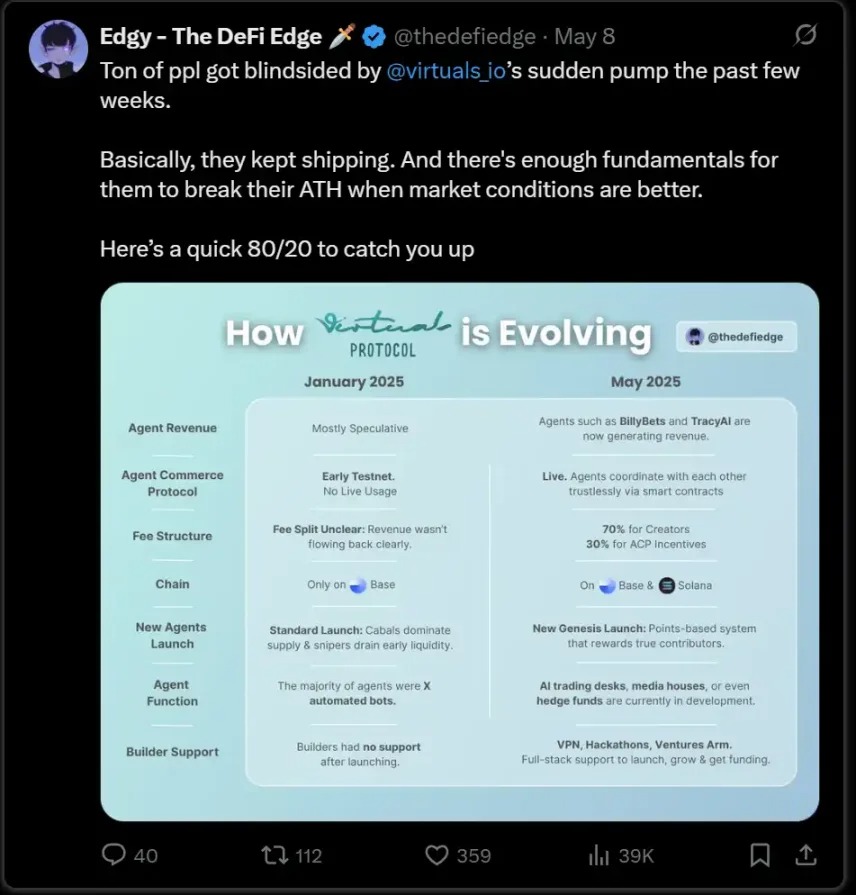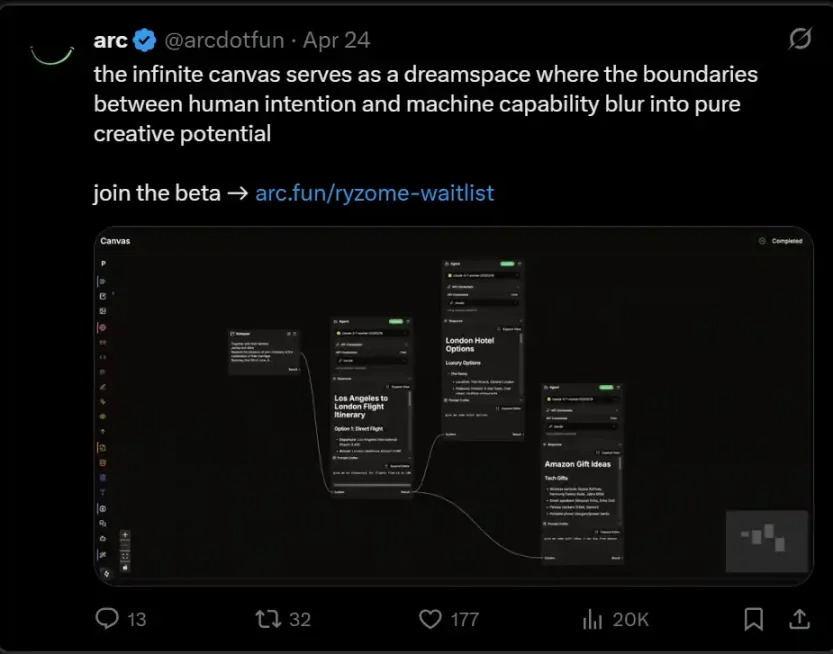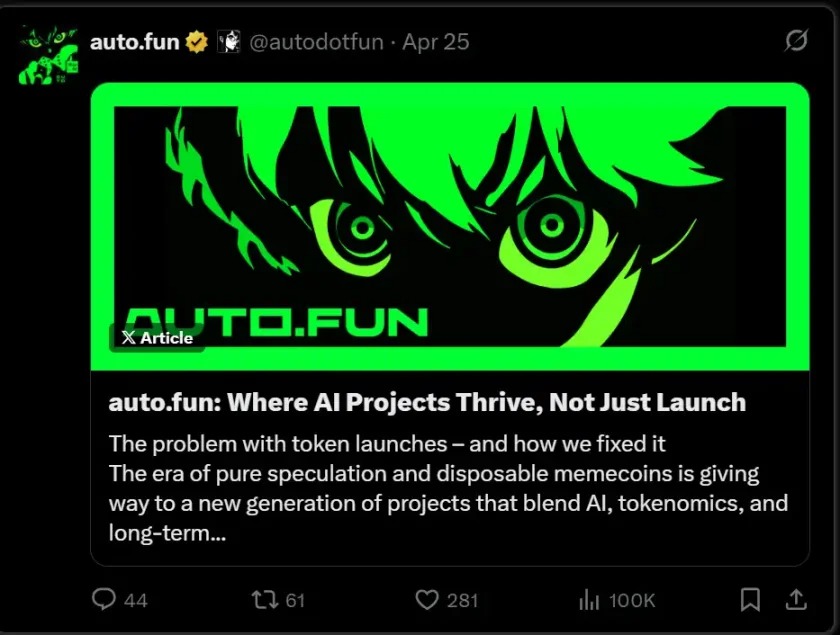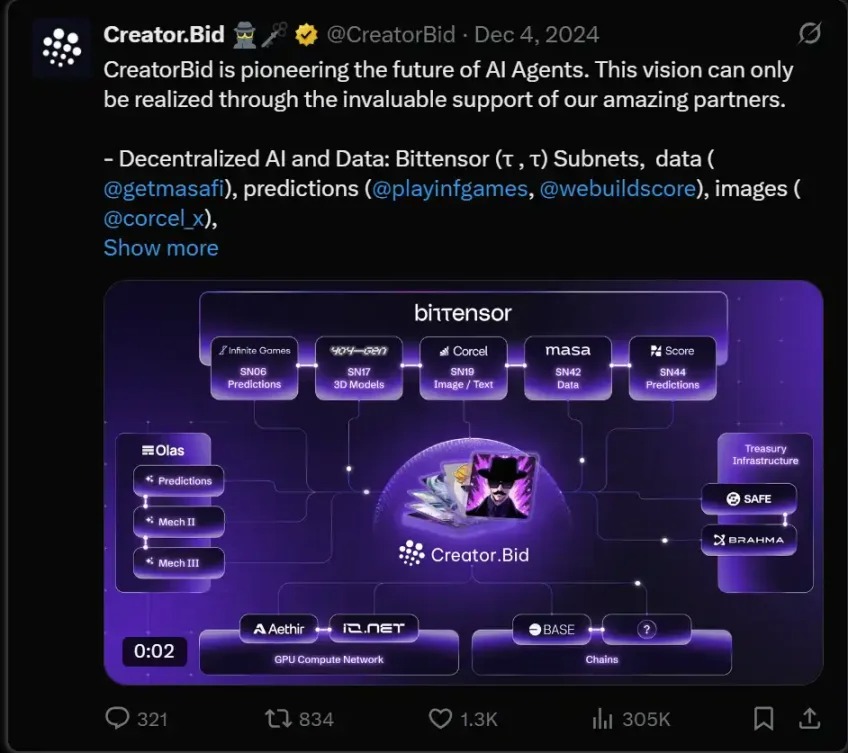Written by: 0xJeff
Compiled by: zhouzhou, BlockBeats
Editor's Note: The article evaluates multiple crypto AI projects in terms of ecosystem building, product iteration, community distribution, and token value, believing that Virtuals is the strongest in maintaining speed and momentum. CreatorBid, while slow in execution, has a clear vision focused on the Bittensor intelligent agent ecosystem with promising long-term potential. The overall AI agent track is still in its early stages, with future focus potentially shifting to infrastructure and real consumption scenarios.
The following is the original content (slightly edited for readability):
It has been about 7 months since the AI Agent wave began. This wave initially started with the birth of @truth_terminal ➙ @pmarca invested in it ➙ someone issued a token for it ➙ it began promoting the token ➙ @virtuals_io launched an agent tokenization platform ➙ AIDOL and conversational agent stages emerged ➙ alpha agent stage, @aixbt_Agent rose ➙ framework stage, @elizaOS (formerly ai16z) initiated an open AI developer movement ➙ small-scale AI x game attempts (but no survivors) ➙ DeFAI stage (vision remains strong, but execution is lacking)
This is roughly a summary of the main stages of the AI Agent track.
Emerging from these stages are a few reliable AI agent teams - they remain active, continuously launching new products and features (though mainly sustained by early accumulated transaction fee income).
Most importantly, some ecosystems remain resilient, supporting developers, helping product ideas start from scratch, and driving AI products and tokens from conception to successful launch.
The Role of Ecosystem Leaders
These ecosystem leaders provide extremely valuable support:
Possess a strong distribution network that can bring attention to your token and project;
Provide product/service integration with the ecosystem core (i.e., facing potential users);
Offer guidance and incubation services from 0 to 1 and then to 10;
Support your idea through investment and funding.
In the Web3 AI field, ecosystem leaders remain the core pillar. This is because community is the core component of the crypto world - the community is key to whether a token can form network effects (unlike traditional SaaS models that rely on subscription fees, Web3 projects depend on tokens to incentivize participation, accelerate growth, and user adoption).
In the past 7 months, we've seen multiple ecosystem leaders rise and fall. But those still active have stood out in the following aspects:
Positioned as an AI Agent app store where developers/users can access Web2 and Web3 services to enhance or automate their workflows - @arcdotfun
Building an economy where autonomous agents trade with each other (and with humans) - @virtuals_io
Leading the largest Web3 open AI movement - @elizaOS
Combining Bittensor's subnet intelligence with AI Agent workflows to attract more people to the @opentensor (Bittensor) ecosystem - @creatorbid
This article will objectively analyze each ecosystem's strengths, who's leading, who's lagging, and so on.
We will analyze from the following perspectives:
Product and Distribution
AI/Intelligence Level
Development Speed
Token Value Capture
Without further ado, let's look at the first aspect:
Product and Distribution
In Web3, tokens are often viewed as a product themselves. But in this article, we define "product" as goods or services that meet actual user needs.
In the Web3 AI field, most products revolve around "financialization" - tools and intelligent services that help people make money, such as Alpha terminals, dialogue agents expressing sentiment about a project, agents that trade or predict, aiming to beat the market, and so on.
Product success largely depends on "distribution". Typically, it's 90% distribution + 10% technical architecture. Few in the industry care about which model your AI Agent uses; they care more about whether its output is stable and whether the insights and alpha it shares are truly useful.
Virtuals

@virtuals_io has the most diverse product ecosystem - including alpha signals, terminals, on-chain/off-chain data, agent workflows for auditing and security analysis, robots, investment DAOs, trading agents, prediction agents, sports analysis, music, DeFi, and more.
Virtuals can be said to be the strongest in storytelling and narrative shaping, and also the best at listening to community feedback and quickly iterating (can be called "survivors").
However, although they offer a wide range of services, only a few teams are truly providing actual value to users (not just entertainment).
Virtuals was the first pioneering player to launch an AI Agent platform, allowing anyone to publish conversational agents and bind a token. This mechanism is a double-edged sword - Virtuals could initially collect fees and capture value from these launches, but since anyone could publish, it attracted many short-term speculators and value extractors who might repeatedly issue tokens or even run away after launch.
(However, Virtuals is developing ACP, and we hope to see some flagship agent products and services soon)
Arc

Players like @arcdotfun have taken a completely different path.
Instead of building a "launch platform" and encouraging as many projects as possible to go online, they focus on creating the AI Agent market "Ryzome" by collaborating with a few high-quality projects, integrating their products and services into their MCP infrastructure.
Additionally, they will launch a no-code/node-based Agent building tool "Ryzome Canvas", where users can access universal MCP server resources and services and use cases from Arc partners to customize agent workflows (similar to Rayon Labs' Squad tool).
Users can sell these workflows or tokenize them and launch them on Arc's Forge (its launch platform).
(In short, Arc follows the "polish the product first, then discuss distribution" route. And Ryzome will be open for testing soon.)
Eliza

Among all frameworks, @elizaOS is the most flexible and versatile.
Eliza supports various integrations, such as secure execution through TEE, trading, analyzing real-time on-chain data, executing smart contracts, managing wallets, etc.
The framework supports multi-agent systems, allowing developers to create a group of agents with different personalities, goals, and key performance indicators (KPIs) to collaboratively complete tasks (such as trading, social media automation, business process automation).
Because of this, Eliza's user base continues to grow, with about 16,000 stars and 5,100 forks on GitHub.
However, although Eliza's framework is highly used, it initially lacked distribution channels. Unlike Virtuals, Eliza failed to capture the momentum and traffic dividend during the early AI Agent takeoff phase (late last year).
This situation changed a few weeks ago - Eliza launched @autodotfun, a launch platform priced in SOL (the next stage will introduce $ai16z liquidity pool), promising to use part of the transaction fees for $ai16z token buybacks.
But so far, autodotfun has not shown significant differences among similar launch platforms, and no truly interesting or unique projects have been launched, which is disappointing.
(Eliza's biggest advantage and disadvantage actually lie in @shawmakesmagic: without Shaw's countless high-intensity inputs, this framework would not exist; but he also often "goes offline and crashes" and makes questionable decisions that cause market FUD, which has happened multiple times.)
AI / Intelligence Capabilities
As mentioned before, the market is mostly focused on "products" and "distribution" rather than the underlying architecture or AI models themselves.
However, if you have a powerful and continuously evolving intelligent system, it is still possible to create a more user-centric product.
For example: A model specifically trained on on-chain data would be stronger in analyzing on-chain information compared to general models; a model trained on sports competition data, crowd intelligence, and real-time data would have an advantage in predicting match results.

Bittensor remains the largest ecosystem with the most diverse intelligent models, and @CreatorBid is the only one truly committed to combining Bittensor subnet intelligence with AI Agent / Agentic workflows.
This team performs poorly in distribution (slow in launching new agents and iterating), but has a clear goal of "firmly supporting Bittensor". (They haven't officially announced it yet, but might launch a subnet called SN98 Creator to further incentivize building Agentic workflows based on Creatorbid.)
Development Speed / User Growth / Project Launch Rhythm
In Web3, if you're building a long-term product, you must consider how to keep the community continuously engaged in the short to medium term.
If you can't "entertain" the community, the token price will often decline over time because no one wants to be trapped long-term. In contrast, the market favors projects that can continuously generate topics and build openly.
Virtuals is the strongest player in this aspect, with open development, quick problem-solving, actively listening to community feedback, and regularly releasing new features or narratives to maintain user interest while building their ACP. Additionally, they often have Genesis Launches for new users.
Eliza ranks second in distribution capabilities, thanks to its developer network and collaborations with multiple L1 / L2 chains. Eliza is also the preferred framework for deploying Agents on other chains (non-Solana). autodotfun also provides an easier launch path for projects.
Arc's Ryzome and Ryzome Canvas are in progress, and once released, they might revive ecosystem heat and potentially activate more Forge project launches.
For Creatorbid, top Agents have recently launched new features (though valuation ranges haven't changed much). CB might be preparing to launch an Agent driven by Bittensor subnet and launch their own subnet. The overall pace is slow, hoping for faster progress in the future.
Token Value Capture
$VIRTUAL is currently the strongest token for value capture, serving as the primary currency for LP construction in the Virtuals ecosystem, and Agents entering Virtuals also need to use it. The recent Genesis Launch introduced Virgen points, which will flow to $VIRTUAL and other ecosystem tokens, further enhancing $VIRTUAL's holding value.
$ai16z might be the second strongest. autodotfun has a daily trading volume of $2-3 million (still far lower than Virtuals and other platforms), with part of the fees used to buy back $ai16z. However, Eliza needs to quickly launch quality projects, especially those with market caps over $10 million, otherwise attention will remain focused on Virtuals.
$arc's value capture comes from LP trading fees and future revenue streams generated by developers on Ryzome. However, this path is still in the early stages and needs time to materialize.
$BID has the most unique token mechanism because its circulating supply is lower than similar projects, and it can stimulate platform activity through token releases. But currently, these releases are not well utilized, with trading volumes still low (between $10,000 to $50,000 daily).
Summary
Each of these projects has its own advantages, but in the short to medium term, "distribution capability" + "ability to attract speculative funds" (i.e., trading volume) is the most critical moat.
The key to system operation is whether they can continuously generate hype and attract players to keep betting in their "casino". In this aspect, Virtuals is currently the best-performing project.
Whether they can maintain this heat long-term and convert it into real product power is worth observing.
Although @CreatorBid's execution still needs improvement, I personally am most optimistic about them because their vision aligns with mine—bringing high-quality AI to the masses and truly commercializing Agentic workflows.
Imagine: A continuously evolving trading signal system that consistently outperforms the market, then transformed into a fully automated trading Agent—this is the concept of SN8 Proprietary Trading Network.
It's still the early stage of the market, and it's not yet clear who will ultimately win. More complex use cases are being handled by large teams outside the ecosystem, such as:
@vana—focusing on data ownership
@NousResearch—reinforcement learning
@TheoriqAI—creating liquidity provision systems
@gizatechxyz—focusing on financial / stablecoin-related agents
In the future, how the leaders of the AI Agent ecosystem position themselves will determine whether they can seize growth opportunities in the next cycle. We might also see more DeAI infrastructure implementation, deeper decentralization of agent systems, and entrepreneurial opportunities across various layers of the technology stack.
Ultimately, speculative heat might shift from individual Agent tokens to core infrastructure for building open AI systems. Perhaps we'll see truly consumer-facing AI products that create real income, rather than short-term speculative bubbles sustained only by "degens" trading back and forth.








